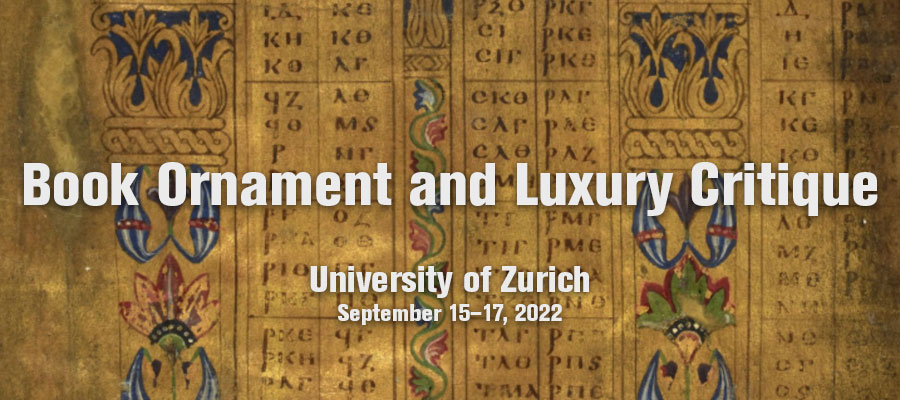Book Ornament and Luxury Critique, University of Zurich, September 15–17, 2022
The research group “Textures of Sacred Scripture. Materials and Semantics of Sacred Book Ornament” invites paper proposals for a three-day international conference on “Book Ornament and Luxury Critique”. The conference, funded by the Swiss National Science Foundation, is scheduled to take place at the Institute of Art History at the University of Zurich from 15 to 17 September 2022.
In his famous preface to Job, Jerome severely criticizes sumptuous luxury in the ornamentation of books: “Let those who will keep the old books with their gold and silver letters on purple skins (…) if only they will leave for me and mine, our poor pages and copies which are less remarkable for beauty than for accuracy” (Praefatio in librum Hiob, ed. Schaff/Wace 1890, 492). While this source is often cited as proof of the availability of luxurious copies of sacred scriptures in Late Antiquity, and the continuation of such splendor – despite clerical opposition – throughout the Middle Ages, the tradition of luxury critique it documents, and its further development, has received far less attention. When, how, and under what circumstances might book ornament be understood as offensive, and which strategies were employed to avoid such critique or to create books that are ostentatiously ascetic?
Since antiquity, philological correctness was opposed to ornament in the rhetorical discourse, which associated an overtly rich language with overblown luxury and female adornment. Already in Roman literature, this gendered discourse was projected onto the material artifacts of writing, a tradition that influenced the varied discussions about the materiality of sacred books and their status in Christian, Islamic and Jewish book cultures from Late Antiquity until the end of the Middle Ages and beyond. In all three religious traditions, the discourse concerning the ornamentation of scripture established connections “between ornamenting bodies, buildings and language, in which fancy forms are rejected in favor of plain, and embellishment opposed to simplicity in a dialect of truth and falsity” (F. B. Flood, in: Clothing Sacred Scriptures, ed. D. Ganz/B. Schellewald, Berlin/Boston 2019, 52).
The conference welcomes proposals that consider the entire range of such critique of book ornament in Christian, Islamic and Jewish book cultures, and that analyze their specific contexts and semantics, as well as “the spaces of negotiation, in which artists, commissioners and users could react to critical allegations without simply obeying them” (D. Ganz, as above, 34). The time range for proposed papers is from antiquity through the Middle Ages and beyond; early modern and Reformation studies as well as broader theoretical approaches are also welcome. Discussions across disciplinary boundaries are encouraged. Topics of particular interest are:
- material semantics of luxury and its opposites (especially the role of color, layout and format)
- critique of gilded script and the clothing of scriptures in gold, jewelry and textiles
- self-commenting books (e. g. Richard de Bury’s Philobiblon) and self-legitimation of ornament
- the ornament critique of the monastic orders
- the economics of luxury and its critique
- the rhetoric of luxury critique
- luxury critique and gender discourses
- luxury critique in an interreligious perspective
The conference languages are English, German, French and Italian.
